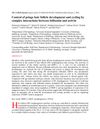TLDR Increased 14-3-3 proteins may block hair cycle regression, causing hair loss.
The study investigated the molecular events in hair follicles (HFs) of Smad4 knockout mice, which exhibited progressive alopecia due to a failure in programmed regression during the hair cycle. Using 2-D difference gel electrophoresis proteomic analysis, researchers identified 86 differentially expressed protein spots, corresponding to 72 proteins, with 29 proteins showing changes during the anagen-catagen transition in Smad4 mutants. The study highlighted that 14-3-3 proteins, specifically 14-3-3σ, 14-3-3ζ, and 14-3-3β, were significantly down-regulated in wild-type keratinocytes but not in Smad4 mutants during the catagen phase. This suggested that the up-regulation of 14-3-3 proteins might contribute to the blockade of catagen initiation in Smad4 deficient HFs, providing insights into the molecular mechanisms underlying hair follicle regression and alopecia.
1279 citations
,
November 2005 in “Nature Medicine”  92 citations
,
June 2005 in “Journal of Investigative Dermatology”
92 citations
,
June 2005 in “Journal of Investigative Dermatology” All-trans retinoic acid causes hair loss by increasing TGF-β2 in hair follicle cells.
40 citations
,
May 2005 in “Journal of Cell Science” Truncated LTBP-1 disrupts TGF-β signaling, affecting hair growth.
 81 citations
,
January 2003 in “The FASEB Journal”
81 citations
,
January 2003 in “The FASEB Journal” Follistatin helps hair growth and cycling, while activin prevents it.
198 citations
,
March 1999 in “Journal of Investigative Dermatology”
 21 citations
,
May 2022 in “Frontiers in Cell and Developmental Biology”
21 citations
,
May 2022 in “Frontiers in Cell and Developmental Biology” Hair growth and health are influenced by factors like age, environment, and nutrition, and are controlled by various molecular pathways. Red light can promote hair growth, and understanding these processes can help treat hair-related diseases.
158 citations
,
February 2012 in “Journal of Investigative Dermatology” 14 citations
,
April 2008 in “PROTEOMICS” Increased 14-3-3 proteins may block hair cycle regression, causing hair loss.
95 citations
,
July 2006 in “British Journal of Dermatology” 276 citations
,
January 2005 in “International review of cytology” 199 citations
,
January 2004 in “The International Journal of Developmental Biology” Hair follicle growth and development are controlled by specific genes and molecular signals.
29 citations
,
April 2003 in “Experimental dermatology” Human hair follicles grown in vitro maintain normal keratin patterns and structure.



